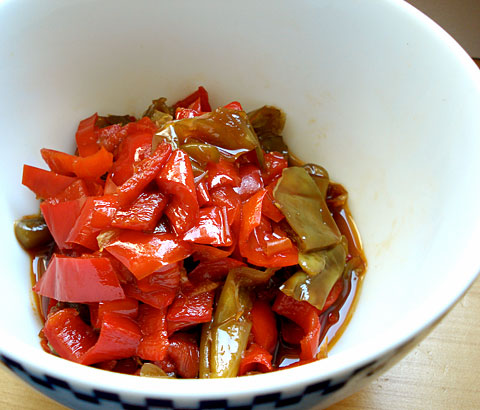
Greenhouse grown peppers are available year round, but summer is when peppers are really in season. I picked up a bushel load of colorful hot and sweet peppers at a market last week, and some of them turned into this item which is great for bento.
It couldn't be easier to make, but does take a little time. A mixture of mildly hot chili peppers and sweet peppers are briefly stir fried in sesame oil, then simmered for about half an hour or more. The peppers are falling-apart soft, spicy, sweet and salty. It's great to tuck into the corner of a bento box, and, well drained of the cooking liquid, also makes a great and unusual filling for onigiri (rice balls).
My grandmother used to make this kind of 'cooked to death' or until very limp (kuta-kuta ni) vegetable dish quite a bit. It's a great way to reduce a big pile of vegetables to a manageable eating amount. This method works well with green beans too. I think it's rather similar to the way some vegetables such as greens are cooked for a long time in American Southern cooking. I'm no nutrionist, but you do eat all of the 'cooking liquor' alongside the vegetables, so nutrition loss may not be so bad, though raw-food advocates may shudder.
The key here is the selection of peppers. The spicy chili pepppers should only be mildly spicy. In Japan you would use shishito peppers. Here I used a variety from Italy that I'm not sure of the variety name of, but it is similarly thin-walled and mild enough not to burn my mouth. Jalapeños or anchos might be good choices too. For the sweet peppers, I used the long red peppers that are called banana peppers, Hungarian peppers or paprikas, depending on who is selling them and where.